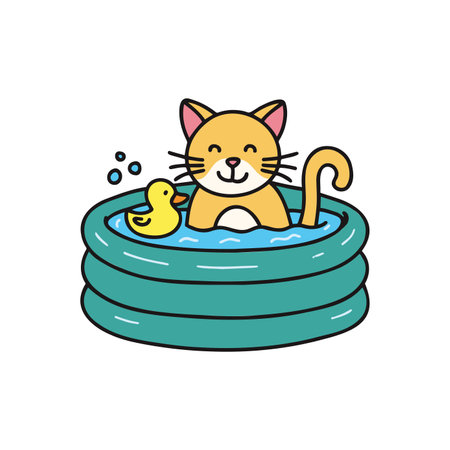1. Understanding Your Cat’s Natural Play Behavior
Cats are natural hunters, and their play behavior is deeply rooted in their instincts. By understanding these instincts, you can choose toys that best match your cat’s preferences and keep them engaged.
Common Play Instincts in Cats
Your cat’s play style is influenced by their natural hunting behaviors. Here are some common play instincts:
| Play Instinct | Description | Ideal Toy Type |
|---|---|---|
| Hunting | Cats love to stalk and capture “prey,” mimicking their hunting skills. | Toys that resemble small animals, such as plush mice or feathered toys. |
| Stalking | They enjoy sneaking up on objects before making a move. | Toys that encourage hiding and pouncing, like tunnel toys or interactive puzzle toys. |
| Pouncing | Pouncing helps cats practice their coordination and strength. | Spring-loaded or moving toys that trigger their reflexes. |
| Chasing | Cats love to chase fast-moving objects, simulating the thrill of the hunt. | Rolling balls, laser pointers, or wand toys with dangling attachments. |
Why These Instincts Matter
Understanding these behaviors helps you pick the right toy for your cat. If your cat loves stalking, they may prefer toys they can sneak up on. If they enjoy chasing, fast-moving toys will keep them entertained. Observing your cat’s play style will help you find the perfect toy that keeps them active and happy.
Tip: Rotate Toys Regularly
Cats can lose interest in toys over time. To keep things exciting, rotate different types of toys every few days to keep your cat engaged and stimulated.
Finding the Right Balance
A mix of different toy types can help satisfy all of your cat’s play instincts. Pay attention to what excites them the most and provide a variety of toys to ensure they stay entertained.
2. Identifying Your Cat’s Preferred Play Style
Every cat has a unique way of playing, and understanding your feline friend’s preferred play style can help you choose the right toys. Cats generally fall into three main play categories: solo play, interactive play, and social play. Observing how your cat engages with different activities will give you valuable insight into their preferences.
Solo Play
Some cats enjoy independent playtime, entertaining themselves with toys they can chase, bat around, or pounce on. If your cat frequently plays alone, they may prefer toys like:
- Small plush mice or balls
- Crinkle toys
- Battery-operated moving toys
- Puzzle feeders
Interactive Play
Cats that thrive on engagement with their humans often prefer interactive play sessions. These cats love to chase, jump, and stalk when encouraged by their favorite person. Great toy options for interactive play include:
- Feather wands
- Laser pointers (used safely to avoid frustration)
- String or ribbon toys (always supervised)
- Treat-dispensing toys that require human involvement
Social Play
If your cat enjoys playing with other pets in the household, they may have a social play style. These cats often engage in wrestling, chasing, or batting at each other’s tails. Toys that encourage social interaction include:
- Cat tunnels for hide-and-seek games
- Bouncy balls for group chasing fun
- Larger plush toys for wrestling
- Sisal-wrapped scratching posts for shared climbing and scratching
How to Identify Your Cat’s Play Style
If you’re unsure about your cat’s favorite way to play, observe their behavior during different activities. The table below can help you identify which category best fits your feline:
| Your Cat’s Behavior | Likely Play Style |
|---|---|
| Your cat plays alone with small objects and swats at them. | Solo Play |
| Your cat brings you toys and waits for you to engage. | Interactive Play |
| Your cat chases or wrestles with other pets in the home. | Social Play |
| Your cat enjoys a mix of independent and human-guided play. | A combination of Solo & Interactive Play |
| Your cat only plays when another pet is involved. | Mainly Social Play |
Tuning Into Your Cat’s Preferences
Cats’ play preferences may change over time, so it’s important to experiment with different types of toys and observe what excites them the most. By recognizing whether your cat enjoys solo adventures, bonding through interactive sessions, or engaging with fellow pets, you’ll be able to provide the best enrichment and entertainment for their personality.

3. Choosing the Right Toy Based on Play Preferences
Every cat has a unique play style, and understanding what excites your feline friend can help you choose the perfect toy. Some cats love to chase, while others enjoy batting at objects or solving puzzles. Lets explore different types of toys that cater to various play preferences.
Interactive Toys for Active Hunters
If your cat loves to chase and pounce, interactive toys like wand toys and laser pointers are great options. These toys mimic the movement of prey, keeping your cat engaged and encouraging exercise.
Popular Choices:
- Wand Toys: Great for bonding time, these toys allow you to control movement, making playtime dynamic and exciting.
- Laser Pointers: Stimulate your cats hunting instincts by letting them chase the elusive red dot.
- Remote-Controlled Toys: Automated movement keeps your cat entertained even when youre busy.
Puzzle Feeders for Curious Cats
Cats that enjoy problem-solving will love puzzle feeders. These toys challenge their minds and provide a rewarding experience as they work to get treats or kibble out.
Benefits of Puzzle Feeders:
- Encourages mental stimulation
- Slows down eating for better digestion
- Keeps indoor cats engaged
Soft Plush Toys for Cuddlers
If your cat enjoys carrying objects around or snuggling with their toys, plush toys can be a comforting choice. Some even come infused with catnip for added excitement.
Recommended Plush Toys:
| Toy Type | Description |
|---|---|
| Catnip-Filled Plushies | Adds extra fun with a scent cats love. |
| Kicker Toys | Larger plush toys that allow cats to grab and kick with their hind legs. |
| Squeaky Plushies | Mimics the sounds of small prey animals. |
Selecting the Best Toy for Your Cat
The key to picking the right toy is observing how your cat plays. If they love chasing things, go for interactive toys. If they prefer solving puzzles, try a feeder toy. And if they like to cuddle, plush toys might be the best fit. Experiment with different types to see what excites your furry companion the most!
4. Safety Considerations When Selecting Cat Toys
When choosing toys for your cat, safety should always be a top priority. Some toys may seem fun and exciting but can pose hidden dangers. Understanding potential hazards will help you make the best choices to keep your feline friend safe during playtime.
Common Toy Hazards
Cats love to chase, pounce, and chew on their toys, but some materials and designs can be risky. Here are some common hazards to watch out for:
| Hazard | Why It’s Dangerous | How to Prevent Issues |
|---|---|---|
| Small Parts | Tiny bells, beads, or plastic eyes can be swallowed or become choking hazards. | Avoid toys with detachable parts or ensure they are securely attached. |
| Strings & Ribbons | Cats love playing with string, but if swallowed, it can cause serious digestive issues. | Only allow supervised play with string-based toys and store them safely when not in use. |
| Toxic Materials | Certain plastics, dyes, and glues used in low-quality toys may contain harmful chemicals. | Select toys made from non-toxic materials and check for safety certifications. |
| Poor Construction | Toys that break easily can expose sharp edges or loose stuffing that may be ingested. | Choose well-made toys from reputable brands and inspect them regularly for damage. |
Selecting Safe and Durable Toys
The best cat toys are designed with both fun and safety in mind. Look for the following features when making your selection:
- No Small Detachable Parts: Ensure all components are firmly attached to prevent choking hazards.
- BPA-Free and Non-Toxic Materials: Opt for natural fibers, untreated wood, or high-quality plastic without harmful chemicals.
- No Loose Strings: If a toy has strings or ribbons, make sure they are securely fastened and not easily pulled off.
- Tough Stitching: Soft plush toys should have reinforced stitching to prevent stuffing from spilling out.
- Easily Washable: Toys that can be cleaned help prevent bacteria buildup over time.
The Importance of Supervised Play
No matter how safe a toy appears, some play sessions require supervision. Interactive toys like feather wands or motorized mice should always be used while youre present to prevent accidents. Additionally, regularly inspect your cat’s toys for signs of wear and tear—if a toy starts falling apart, replace it immediately.
A Safe Play Space Matters Too
Apart from choosing safe toys, consider where your cat plays. Avoid areas with potential hazards like electrical cords, sharp furniture edges, or small objects they could swallow. A designated play area free from dangers ensures an enjoyable experience for your pet.
Your cat’s safety is just as important as their entertainment. By selecting well-made toys and being mindful of potential risks, you can create a fun and secure environment where your feline companion can thrive!
5. Keeping Playtime Engaging and Fun
Cats are natural hunters, and their playtime should mimic the excitement of stalking and catching prey. To keep your feline friend entertained and prevent boredom, its important to rotate toys, introduce new ones, and engage in interactive play. Here are some tips to make playtime exciting for your cat.
Rotate Your Cat’s Toys
Just like humans, cats can get bored with the same toys over time. Rotating their toys keeps things fresh and exciting. Try these simple strategies:
| Rotation Strategy | How It Helps |
|---|---|
| Swap out toys every few days | Keeps your cat interested by reintroducing “new” toys |
| Store unused toys in a box | Makes old toys feel exciting again when brought back |
| Use different types of toys in rotation | Ensures variety between plush, wand, and puzzle toys |
Introduce New Toys Gradually
Cats can be cautious about new objects, so introducing new toys gradually will help them feel more comfortable. Here’s how:
- Start with familiar scents: Rubbing a new toy on your cat’s favorite blanket or using catnip can make it more appealing.
- Add one toy at a time: Too many new items at once can overwhelm your cat.
- Observe their reaction: If they ignore the toy initially, try incorporating it into playtime later.
The Importance of Interactive Play
Cats thrive on interaction, especially when it mimics hunting behavior. Playing together strengthens your bond and keeps them active. Try these interactive play ideas:
Use Wand Toys Effectively
- Mimic prey movements: Move the toy like a bird fluttering or a mouse scurrying.
- Avoid predictable patterns: Change directions and speeds to keep your cat engaged.
- Let them “catch” the toy: Allowing them to catch and “kill” the toy satisfies their hunting instincts.
Create Puzzle Challenges
Puzzle feeders and treat-dispensing toys stimulate your cats mind while providing a fun reward system.
Puzzle Toy Benefits:
- Mental stimulation: Encourages problem-solving skills.
- Satisfies hunting instincts: Provides a rewarding challenge.
- Aids in weight management: Slows down eating if using food puzzles.
Avoiding Playtime Burnout
If your cat loses interest quickly, try shorter but more frequent play sessions. A few five-minute sessions throughout the day may be more effective than one long session.
Your cat’s play preferences may change over time, so stay observant and adjust accordingly. Keeping playtime engaging ensures they remain happy, active, and mentally stimulated!


